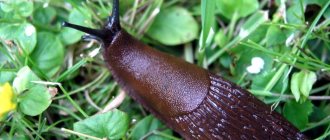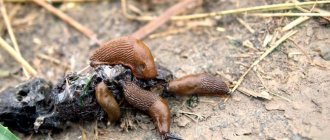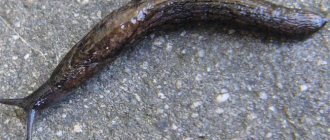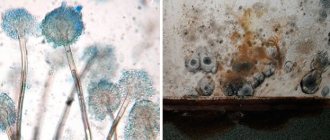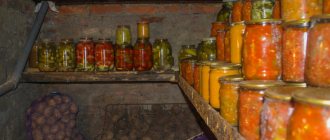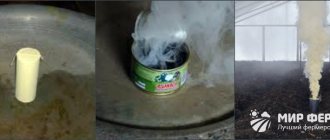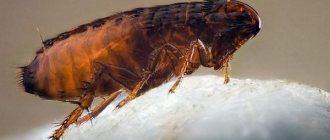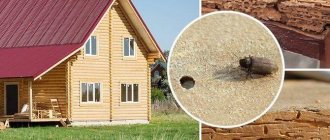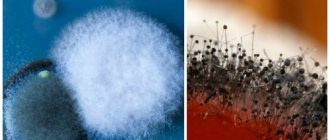Jacobs Monarch instant coffee, 190 g
406 ₽ More details
Jacobs Monarch instant coffee, 500 g (package)
876 ₽ More details
Mountain bikes
Almost all gardeners are faced with such a pest as the slug. Due to its unpretentious diet, it causes great problems for growing useful crops, as it eats tubers, vegetables, fruits and young shoots.
Slugs require moist, cool temperatures to grow and reproduce. The cellar is an ideal place to live for these animals. It almost always contains vegetables and root crops for food, as well as high humidity and a constant microclimate suitable for slugs. Although they do not completely eat the fruits, by damaging the top layer, they contribute to their spoilage and can destroy the entire harvest. Therefore, at the first sign of appearance, you should apply all the necessary knowledge and remove them from the premises.
Get rid of slugs in your cellar
Who are slugs and where do they come from?
A slug is an animal belonging to the class of gastrosexual mollusks, similar to snails, but without a shell. The middle climate zone is most suitable for their residence.
The body of the animal is elongated and flattened. In front there are tentacles in the form of horns, on which olfactory, taste and optical receptors are located. There is also a mouth in which there is a tongue and jaws with sharp teeth. With their help, the pest bites off and grinds food. Behind the head there are organs for breathing and excreting waste. The back part is the leg with which the mollusk moves.
Slugs are nocturnal animals and feed mainly at this time of day. They are bisexual and both individuals are fertilized, which leads to the laying of a large number of eggs. The growth of a new organism takes about 14 days. The species is resistant to low temperatures and promotes high fertility.
Pests can enter the cellar through cracks. They are attracted by comfortable constant humidity and temperature, allowing them to live all year round. Animals are also brought in along with food intended for storage in the basement.
Home remedies for cellar, basement
Barrier traps are used for basements. The action is based on the fact that not all surfaces are accessible to pests: their lower body is very vulnerable. The mollusk will not crawl along cutting, piercing, or sharp surfaces. Craftsmen took note of this moment, creating barriers for slugs to enter the house and cellar.
To create barriers, expanded clay, brick chips, coarse sand, and lime are used.
Place “barriers” in strips up to 20 cm wide in places where slugs may enter the house or cellar.
What types of slugs are there and what harm do they cause?
There are many types of slugs. Classification occurs according to the following parameters:
- To size. The length is very different, ranging from 2-300 millimeters. The largest is considered to be the black slug.
- Nutrition preferences. There are cabbage, grape and other types.
- By color. They are distinguished by light, spotted, black, versatile colors.
- By location. The most common are forest and garden, and in terms of geographical habitat - European. The latter species is harmful not only to vegetables and fruits, but can also be poisonous to other animals, as it carries parasites and is dangerous to the lives of pets.
Shellfish cause irreparable damage to vegetables and fruits destined for storage in the basement. When the required dryness is not ensured in the cellar, you will have to constantly fight slugs. They do not pose any hygienic harm, but spoiled products rot very quickly.
Slugs prefer grain crops most strongly. Less interesting are cucumbers, parsley, garlic and onions. The trace left when moving is also dangerous for plants. It contains microbes and bacteria that contribute to the growth of diseases in vegetable and fruit crops.
Folk remedies
Since the presence of slugs and the damage from them is a long-standing problem known to people involved in growing various crops and plants, a number of folk remedies have been developed to combat these pests:
- Shellfish are attracted to beer and fruit aromas, so you can treat burlap or some other material with these drinks, and then spread it out in the garden in the evening. By morning, a significant number of individuals should flock to the smell, and all that remains is to destroy them.
- Salt and soap are two things that all types of shellfish cannot tolerate. You can dig small holes around the perimeter of flower beds or beds, where you can place containers filled with soapy water or salt water. The top of the vessels is covered with rags or burlap so as not to attract unnecessary attention. The smells from the solutions will repel slugs, and if one of them crawls through the wet material, they will soon die.
- Any porous surfaces are a real problem for any shellfish, as they are difficult to move on. Knowing this feature, you can make life difficult for pests by scattering eggshells, shell fragments, sharp pebbles or small gravel over the beds. They will prefer not to move on such soil, which will reduce access to plants.
- Once a week, plants can be treated with lemon solution, which will scare away all uninvited guests. For its preparation, about 25 grams are used. citric acid, which is diluted in 10 liters of ordinary water.
- Periodically water the passages between the beds with ground coffee, which is pre-dissolved in water.
- Wood ash or tobacco ash is another effective deterrent that can be sprinkled on or around your garden beds.
Methods for removing slugs in the basement of a house
How to get rid of annoying slugs in the cellar? Pests can be controlled in different ways. They are divided into preventive (not dangerous for the products in the cellar) and slug-killing (chemical preparations). Methods are divided into corresponding groups:
- Collecting pests manually using traps.
- Arrangement of barriers to prevent shellfish from entering the cellar.
- Using chemicals to kill animals.
- Using smoke bombs to clog the airways of pests that have entered the basement.
- The fight takes place using folk methods.
All actions to remove slugs from the basement and fight them produce the best effect in combination. It is also preferable to carry out prevention or destruction together with neighbors, since if the environment familiar to slugs changes, they will move to adjacent areas.
Substances containing metaldehyde are strictly prohibited for use in the basement due to the negative impact on food stored in it.
How to use chemicals to get rid of slugs in the basement
This method of fighting slugs involves quickly destroying them using fumigation. But you need to be extremely careful not to get exposed to chemicals and poison the food stored in the cellar.
The most effective way to get rid of slugs is sulfur fumigation. It is necessary to remove the reserves and plug all the cracks. You should put on a gas mask or a gauze bandage and spray the substance into all parts of the basement. It is necessary to close the room for a long time, and then ventilate well, rinse and dry.
Another method of removing slugs is to kill them with chemical poisons; very effective drugs to combat slugs are cronetron, metal hydride and ferric iron orthophosphate. Their action is to turn pests into slime. After using the poison, the basement should be ventilated for at least 7 days.
How can creating barriers help get rid of pests?
The lower part of the clams is very tender. This prevents them from crawling over obstacles. Therefore, the simplest method of protecting against pests crawling into the cellar is to install a barrier in the form of unnecessary building materials, salt, ash, and crushed shells. This artificial barrier must be continuous to prevent the formation of passages through which slugs can penetrate the makeshift barrier. The stability of the barricade must be periodically checked and its integrity must be constantly monitored.
Use chemicals to kill slugs
Smoke bomb
To ensure rapid destruction of slugs in the cellar, a sulfur smoke bomb is used. It accurately ensures that shellfish disappear and prevents their reappearance. But you need to follow certain rules:
- Clear the basement of edible products.
- Seal the room.
- Provide yourself with protection.
- For large basements, install several checkers for the best effect.
- Leave the cellar, having previously tightly closed all entrances.
- After the action, you must not open the room for 2 days.
- Then you should ventilate for at least 24 hours.
- Carry out wet cleaning, after which the room is ready for operation.
This method allows you to destroy not only adult slugs, but also a clutch of their eggs.
Slug Traps
A more humane way to combat slugs is with traps. If the cellar has the option of raising the products to a height, then in their place there will be increased humidity, which the mollusks strive for. After they are collected in the wettest area, all that remains is to collect them and remove them from the room.
A very well-known method is the beer slug trap. Experienced gardeners use only dark beer for these purposes. The method is very simple: a plastic cup is filled halfway with beer, the smell of which attracts pests, they crawl in and drown. The main thing is to change the drink every 3 days so that the smell does not dissipate.
Traditional methods of fighting slugs
Methods that allow you to remove animals using folk remedies are also effective. There are many substances for getting rid of shellfish:
- ammonia, which repels slugs;
- brewed coffee;
- table vinegar;
- salt and mustard;
- mixed tobacco and ash.
Traditional medicine recipes are very popular and widespread due to the ease and accessibility of dacha ownership.
What to process?
Dusting with lime, as well as a mixture of wood ash and chalk, helps against slugs in the basement.
All vegetables and equipment are removed from the basement and the cracks are sealed. Then thoroughly dust the room. This treatment kills the slugs instantly; they are collected and thrown away.
After dusting, the entire basement is whitewashed with lime. The basement is dried, ventilated and only after that the vegetables are brought back. The dusting method is most effective at the initial stage of slug colonization in the basement.
Preventive measures against slugs
There is nothing better than prevention. How to deal with slugs? It is necessary to regularly dry the cellar, but use special treatment substances that help protect not only from slugs, but also from other parasites.
The most popular methods of prevention:
- place wet rags and collect animals crawling there;
- treat the walls and floor with a salt solution;
- sprinkle dry mustard;
- whitewash the walls and ceiling;
- Provide the cellar with good ventilation to reduce humidity.
To preserve food in the cellar, it is very important to know how to get rid of shellfish. Although they are not the most harmful parasites, under favorable conditions they can destroy the entire crop. The main thing is to keep the basement dry and remove slugs from the cellar in a timely manner.
Pest control on cabbage
Of all the vegetables in the garden, cabbage is especially loved by slugs.
Its juicy, tender leaves are the best delicacy for pests, and very often they destroy the entire crop on the site. It is highly undesirable to use chemicals on cabbage, especially since there are many effective and affordable folk remedies.
Spraying
Experienced gardeners recommend spraying cabbage with hot water. This vegetable can withstand temperatures up to 60 degrees without consequences, while slugs die at 40 degrees.
If pests are visible between the leaves on the heads of cabbage, you need to heat the water to 40-45 degrees and thoroughly spray the plants.
The treatment should not be long so that burns do not remain on the leaves. Dead shellfish must be manually selected from the sheets after a hot shower.
Instant coffee helps get rid of slugs well. Upon contact with caffeine, large individuals lose activity and orientation, and small ones die.
To spray, just dissolve a double portion of coffee powder or granules in a glass of water, and then treat the cabbage. Having smelled the smell, slugs will avoid cabbage beds, but coffee does not harm the plants.
Pests also do not like the smell of wormwood, tobacco, marigolds, and walnut leaves. They need to be brewed in boiling water, left for 2-3 hours, then the cabbage should be treated with strained and cooled infusion.
Occasionally, you can use a weak saline solution (100 g per bucket of water) or a solution of ammonia in a ratio of 1:6.
Traps
During the day, slugs always hide from the heat in thick grass, under stones, and in compost heaps. You can make your own slug traps. To do this, you will need available materials: old boards, pieces of slate, burlap, roofing felt and other rubbish.
Having chosen a convenient open place, you should water it thoroughly and lay any material on top. Burlap and rags must be additionally moistened with water.
In a day or two, slugs will gather under the shelter; they should be collected and taken away from the site, and the shelter should be left for the next batch. See the photo below for what a slug trap looks like.
A good trap can be made from an ordinary plastic bottle. The bottle is crushed on the sides so that it does not roll on the ground, a little fruit juice, honey or beer is poured inside, and placed flat between the cabbage beds.
You can press it down on top with a flat stone or board, fixing it in one position. Slugs will definitely smell the smell and get into the bottle, but it will be difficult for them to get out.
Once every 2 days you need to check the traps, remove any pests and add juice.
Lures
Another way to catch slugs is to place bait in the area. Grapefruit, orange or watermelon peels are used as bait; To do this, they are cut in half, the pulp is selected, and a small hole is cut in the center of the peel.
The resulting cups are placed cut side down on the beds in the evening; Attracted by the aroma, the slugs crawl under the skin and remain there until the morning. After this, all that remains is to check all the baits and collect the shellfish.
How to protect cabbage and strawberries from slugs?
Slugs' favorite treats are strawberries and cabbage.
Gentle methods of control:
- collect in the morning;
- keep the garden clean;
- rotate vegetable crops in a timely manner;
- attract birds, hedgehogs, frogs, etc. to help.
Mechanical control:
- Place plastic or metal gutters around the perimeter and periodically fill with water.
- Sprinkle between rows: gravel, shells, eggshells, etc.
- Use special granular materials that are scattered around the plantings, and they, in turn, create a barrier.
- Buy plastic rims that are fixed in the ground.
- Install raised beds.
- Make traps.
- Purchase biological control products: powder containing the desired microorganisms is diluted with water and watered over the plantings.
- Apply phytocontrol: planting garlic, herbs, etc.
- Use folk remedies.
The main thing is, of course, prevention. Well, the last thing you need to use is poisoning with chemicals.
How to get rid of slugs on cabbage?
Cabbage is the most favorite delicacy of slugs. Early varieties suffer even when the first leaves are formed.
We start with the correct landing. Plant seedlings at a distance of 50 cm and no more. Such placement will not allow creating favorable conditions for living: shaded, dense, humid areas.
After planting, put a ring on each seedling:
It is more convenient to cut from a 2-liter bottle
The edges should have uneven jagged edges of varying lengths.
The seedlings are carefully threaded into the neck. The jagged edges will easily damage the slug's body if it decides to eat the cabbage.
When the head of cabbage begins to form, the lower leaves, especially those in contact with the ground, must be torn off.
A folk remedy has worked well: fresh wormwood leaves and whole nettles are placed around the cabbage, changing from time to time.
Get rid of it this way:
- water in the evening with water + 50°;
- Cabbage can easily withstand this temperature, but slugs cannot.
Spray with red hot pepper solution:
- grind 80–100 gr. pepper (in pods);
- soak in 1–1.5 liters of water;
- leave for 2–4 days;
- boil for 5–10 minutes;
- leave for 1–2 days.
Mode of application:
- 100 ml of infusion, diluted in 10 liters of water;
- rub some laundry soap there;
- Spray the cabbage.
Mechanical destruction
Diagram of a slug trap.
So, the first method of struggle is the most primitive, but quite effective. It consists of mechanically catching slugs in the cellar. To do this, first of all you must set traps. These can be low containers with wet soil, water, or half-rotten food. You can also use wet pieces of rags. This must be done at sunset.
Early in the morning, when most of the slugs will already be concentrated in the traps, you just need to take them out of the cellar and destroy them. This must be done many times every day until one day you notice that there are no more shellfish in the trap.
Along with this method of control, it is simultaneously necessary to seal all small cracks in the floor and walls of the cellar and treat it with antiseptic preparations. It is also necessary to frequently ventilate and dry the room. This way you will maintain the desired temperature inside, but at the same time the humidity will be normal.
Cellars Kuzmich
Slugs are a real disaster for the cellar and its supplies. And it doesn’t matter how it was created: brick or plastic. Dampness and humidity, cracks are the main reason for the appearance of guests. But at the same time, pests are not able to appear in Kuzmich’s monolithic cellars. Our cellars are made of hydroconcrete M-400/B20/W12 and have additional layers of waterproofing, so moisture from the outside simply cannot appear in the room.
In addition, the cellars already have properly functioning ventilation and a sealed hatch, thanks to which the air will be relatively dry. Interior decoration, carefully crafted corners and seams, a completely monolithic body - ideal protection against various kinds of pests, mold, mildew and other troubles that lie in wait for fresh vegetables in the cellar.
In addition to everything, we equip the Kuzmich cellars with shelves and racks, a ladder, and an LED lamp. This is a completely ready-to-use cellar, reliable and safe.
Prevention
If the slugs have been removed, it is necessary to prevent their reappearance. To do this, the cellar, as we said above, needs to be “taken care of.” To do this, summer residents usually:
- create good ventilation;
- constantly ventilate the room;
- check cracks at the first sign of pests;
- In autumn and spring, sprinkle corners and floors with mineral fertilizers or salt. These substances act on slugs like naphthalene on moths. Death comes quickly.
- regularly inspect their vegetable supplies for the appearance of slug colonies.
Alexander says:
One season, we were overcome by slugs. In their gluttony, they were not inferior to locusts, they ate ALL the greenery, right down to the very root. They spent many days fighting this scourge. I sprinkled the beds with slugs with lime and ash in a layer of more than one centimeter. After 30 minutes, the slugs crawled out of the “den” formed from sticky lime and ash, and continued their devastating raid. They tried to water with all sorts of chemicals, everything was in vain. They managed to win, only with the help of a natural factor, the rains came to replace dry heat...
